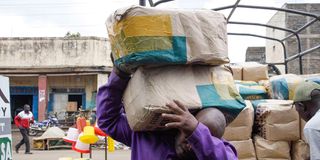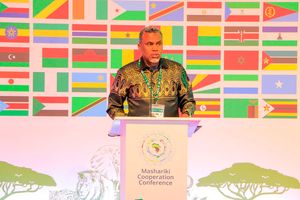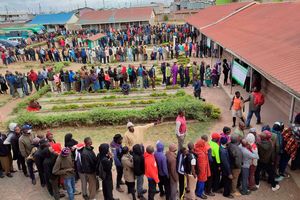
Workers offload bales of maize seeds for planting in Elburgon town, Nakuru County on March 18, 2025.
Various counties have been distributing free certified maize seeds to their farmers. Some counties include fertiliser in their package. They include Tharaka Nithi, Embu, Lamu, Trans Nzoia, Busia and Murang’a.
It is easy to dismiss such interventions as tokenisms that are unsustainable in the long term. Governments acting as father Christmas doling out goodies, some economic libertarians might argue.
But there are deeper economic reasons and logic behind these programmes.
The first reason is an attempt by counties to tackle the problem of fake and substandard seeds in the market. The World Bank has indicated that in some African countries, up to half of all seeds sold are counterfeit. The use of counterfeit seeds can lead to lower yields. In some instances less than one-fifth of their potential.
It has been reported that Kenya Plant Health Inspectorate Services (Kephis) seized fake maize a few years ago in Kiambu. That means even farmers with the capabilities of buying certified seeds do not trust the private sector to deliver certified seeds. As a consequence, counties procure certified maize seeds from known national government institutions that supply certified maize - Kenya seed and Simlaw seed - and deliver them straight into farmers' hands. This traceability of seeds from known source to farmgate is an important proposition of these emerging county seeds distribution programmes.
If the national government was to robustly curb fake seeds, the appetite for county seeds might diminish.
The second rationale is saving farmers out-of-pocket expenditure on maize seeds and fertiliser. One 2kg packet of maize seeds costs Sh1000. Planting fertiliser costs Sh2500 for a 50kg bag. Same price for top dressing fertiliser. Whereas very few counties give a wholesome package to farmers, nevertheless their intervention saves on average Sh3000 per farmer. Farmers can expend those savings on something else.
Food security
The third rationale is boosting food security as a county's strategic goal. Maize remains a staple food for most Kenyans. Maize farmers have consistently reported diminishing output as a result of the inability to afford fertiliser and certified maize seeds.
In Muranga, most farmers have half an acre portion where they farm maize. Traditional maize seeds yield one bag or less of maize. These varieties are not drought and pest resistant, unlike certified seeds. Certified maize seeds plus fertiliser can triple or quadruple the yield.
The fourth rationale is an economic one but a summary of all the above. The yield of these programmes reveals a good return on investments. This rainy season, Muranga County invested around Sh50 million to buy fertiliser from the National Cereals and Produce Board and Sh45 million to purchase seeds from Simlaw Seeds (totaling Sh95 million) to distribute to 80,000 farmers. If each farmer produces an average of 2 bags (an understatement), that translates to 160,000 90 kg bags of maize. The current market value is Sh4000 per 90kg bag of maize hence total value is Sh640 million. An investment of Sh95 million yields Sh640 million.
Assume the two bags are converted into flour.
Converting 90kg of maize yields 75Kg of flour. Two bags of maize are thus given 150kg of flour.
The average price of flour per kg is Ksh 80.
Therefore 80,000 households × 150kg of flour x Sh80 price per Kg = Sh960 million as money saved in the event the 80,000 households would have bought flour in the absence of maize. Household saving is Sh12,000 (Sh960 million divided by 80,000 households).
Malawi, during the reign of the law Bingu Mutharika in 2000's, had perfected this programme for small-scale maize farmers. There is no reason why Kenya can not replicate this success and become a net grain exporter.
However, the programme has challenges that counties need to remedy. First is the logistical nightmare of distributing maize seeds and fertiliser across various counties. Counties are vast. Hauling such a huge consignment is a huge task. Storage, transportation and ground distribution logistics require planning.
Skills
Second, the number of farmers can overwhelm. Last season, of December 2024, Muranga, for instance, had registered about 57,000 farmers. Around 80,000 turned up on the material day of distribution. This season, the county planned for the 80,000. Around 120,000 turned up. How to deal with the unregistered cohort requires skills and tact.
Based on various feedback from leaders and farmers, some of the above conundrums can be solved through advanced but continuous registration of farmers. Adding vetting mechanisms by providing application mechanisms creates audit trails and weeds out undeserving applicants.
Single-day distribution as opposed to a staggered schedule might remedy the potential risk of repeat beneficiaries. Increasing distribution centres preferably to the polling centre level reduces crowding and tussling as numbers are split.
Deployment of technology during registration and issuance makes the process less prone to manipulation.
Engaging youths to secure local stores at the polling centre level boosts legitimacy of the programme beyond the elderly cohort that usually farms.
All in all, this might be what the doctor ordered to make Kenya food secure.
Dr Irungu Kangata is the Governor for Muranga County. Email franciskangataik@gmail.com










